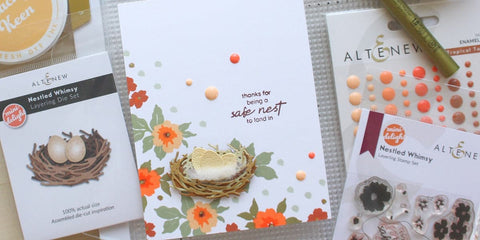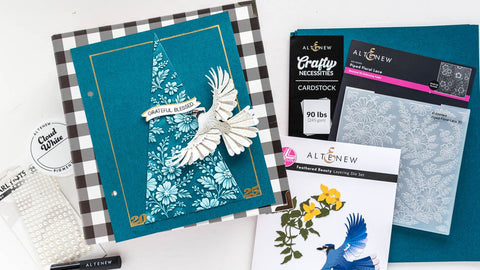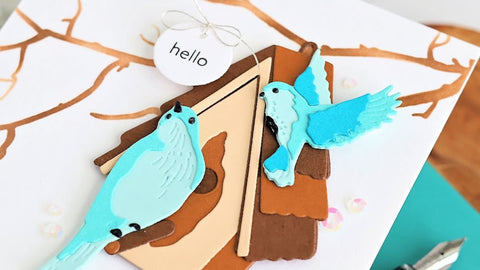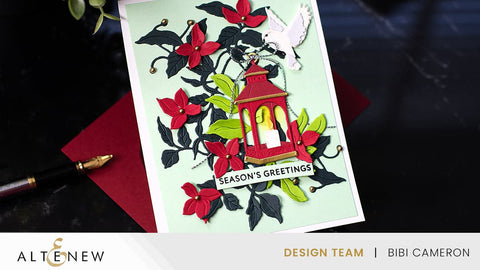How to Capture the Beauty of Florals With Liquid Watercolors
Last Updated: October 28, 2025
When it comes to creating our paper crafting projects, many of us are attracted to the enchanting allure of floral designs. Not only are they pleasing to look at, but they're also fun to color - especially with liquid watercolors! Flower images have many beautiful coloring possibilities - but creating depth and interest with liquid watercolors is a great way to go about it.

Liquid watercolors provide stunning hues that capture the natural charm of florals in such brilliant detail – and we'll show you how! In this blog post, we'll take a closer look at why liquid watercolors are fantastic for coloring flowers, how to use liquid watercolors, and how you can have fun with your florals using this versatile medium.
What Makes Liquid Watercolors So Great?
Liquid watercolors are excellent for coloring your projects because they are highly pigmented, easy to mix and blend, and have a smooth, fluid consistency. Compared to other watercolor mediums, such as pans or tubes, these washable liquid watercolors come in a portable bottle with droppers. This feature makes it easy to control the amount of pigment you'll use. Plus, its sleek design makes your storage and clean-up process easier.

A Guide to Liquid Watercolor Paints
They can be used for various techniques - from delicate washes to bold, expressive strokes. Because they are water-based, all you have to do is control the amount of water for less or more intense colors. Just add more water for a lighter wash, and use less water for more vibrant colors. Additionally, liquid watercolors also dry fast, which gives you more control over layering and blending techniques and effects.
Since they’re so pigmented, a little goes a long way, and you can buy them individually or in sets, making them so economical! Unlike other watercolor mediums, which come in sets, you can mix and match different colors, even from different sets, giving you more creative freedom to blend your own colors.
Why Are Liquid Watercolors Perfect for Floral Designs?

Watercolor Brush Markers - Winter Wonderland Set
If you're like us and love using floral stamps, dies, stencils, embossing folders, and more for your designs, we highly recommend experimenting with liquid watercolors! From blending techniques to unique brush strokes and patterns, these small but mighty coloring tools will do a perfect job of bringing your flowers to life. Whether you're a beginner or an expert, liquid watercolors allow you to color any kind of flower easily with just a few simple techniques:
Adding Depth to Petals and Leaves
Since liquid watercolors are easily blendable, you can easily use them to create two-toned effects for your petals and leaves, resulting in a more realistic image.
One way to add depth to petals and leaves when you use liquid watercolors is to layer the colors. Start by applying a light wash of color to the entire petal or leaf, then add a second layer of color to the areas where you want more depth, such as the edges or creases. You can do this by mixing in a darker hue or adding more pigment.

Ruby Red Liquid Watercolor - Brush Marker Refill
Another way to create depth in your flowers is through the "lifting" method, wherein you remove pigment from certain areas to mimic highlights. You can lift pigment by lightly dabbing a paper towel to absorb colors. Using highlights and shadows on your flowers will significantly give them more dimension, rather than just coloring them in one shade.
Making Vivid Backgrounds to Lift Your Flower Images

Another way to level up your floral projects is by creating vivid backgrounds for them, especially for light-colored flowers that leave a lot of negative space. Like Emily's design above, using a blending technique to serve as a background for your light-colored floral images can make them appear like they're popping off the page. For this technique, you can also do "glazing," which involves building depth by allowing layers to dry before you apply more pigment. Because liquid watercolors are fast-drying, you'd have no difficulty with glazing at all!
To do this design for light flowers, simply replicate the following steps:
- First, use a dark liquid watercolor to make a halo around the design. Make sure to use a fine-tipped brush.
- After doing the dark edges, simply mix hues that are in the same color family as the dark halo. For example, if you use a dark green color, use light to medium tones of green to create shadows and highlights around the flower.
- Remember to color around the image, and leave room for white spaces to serve as the highlights for the background.
- Finally, color your flowers in the middle, and voila! You now have a beautiful light flower that shines because of the contrast caused by your background. How cool is that?
Remember to have fun experimenting with the type of brush strokes and colors you use.
Creating Textured Floral Looks With Die-Cuts
Liquid watercolors are not just good for painting stamped or heat-embossed images. They're also great for coloring your die-cuts! Using the bold and vibrant colors of liquid watercolors will amp up the look of your die-cuts easily, giving them an elegant watercolor texture. You might think this technique is complicated, but don't let the impressive results fool you - it's as easy as loose watercoloring!

Ultraviolet Liquid Watercolor - Brush Marker Refill
Together with your layering die sets, you can easily add color to your layers with just a few drops of liquid watercolors.
- Alternate between water splashes and colored splashes by experimenting with putting more pigment and more water in various areas of your watercolor paper. You can use different shades of color for this method.
- Make splatters by loading pigment on your brush and lightly tapping them on your paper.
- If you want less-pronounced splatters, use a wet-on-wet technique for a softer color blend.
- Once you're satisfied with the color wash, die cut your flower's layers on the colored watercolor paper.
Remember to use dark layers for the inside and central parts of the flower, and use lighter layers as you cut the petals to imitate highlights. The process can look pretty tricky when reading, but it's easier to do this technique by following Erum's handy video below:
Add Vibrant Flair to Your Florals With Liquid Watercolors!

Warm Sunshine Liquid Watercolor - Brush Marker Refill
If you haven't used liquid watercolors before, now is the time to start doing so. They are easy to use, highly pigmented, and can take your flower images up a notch with their wonderful colors!
With a bit of practice, you can master these techniques with coloring florals and explore more liquid watercolor projects. Remember to have fun with it, and don't be afraid to make mistakes – liquid watercolors are forgiving and can often lead to unexpected and beautiful results.
We hope you enjoyed learning how to use liquid watercolors for floral designs. Be sure to check out our other tips on our All About Crafting blog for more watercolor tutorials and techniques like these. Happy coloring!
4 comments
In This Article
More Crafty Reads & Inspirations
-

Clean and Simple Cardmaking with the Mini Delight - Nestled Whimsy Set
-

Bring Class and Elegance to Your Projects (+With Video Tutorial)
-

Pairing Die Cutting with Stenciling for Scene Building (With Video Tutorial)
-

Festive Decorative Lantern Holiday Card Design Idea
-

Simple Focal Point Techniques with Big Impact!
















We are glad you found this helpful, Anne! Your feedback means everything to us. Thank you :) <3
This is very helpful. Thank you for the instructions.
Comments like yours keep us inspired, Maryh! Thank you for your kind words <3
Very helpful with lots of easy to follow tips. Find these articles interesting and informative.